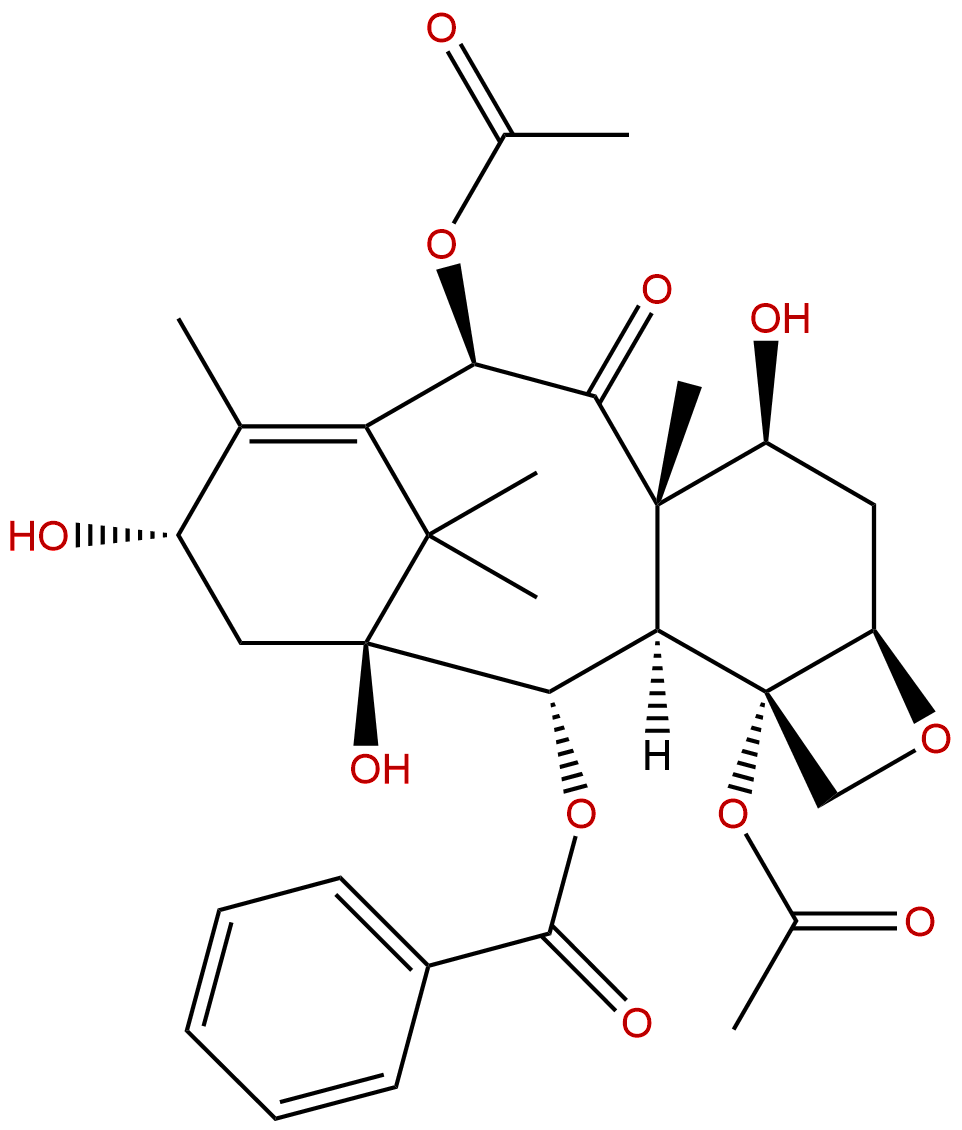
Baccatin IIICAS No.:27548-93-2
|
||||||||||
 |
|
|
||||||||

| Catalogue No.: | BP0225 |
| Formula: | C31H38O11 |
| Mol Weight: | 586.634 |
Synonym name:
Catalogue No.: BP0225
Cas No.: 27548-93-2
Formula: C31H38O11
Mol Weight: 586.634
Botanical Source: Taxus baccata
Purity: 95%~99%
Analysis Method: HPLC-DAD or/and HPLC-ELSD
Identification Method: Mass, NMR
Packing: Brown vial or HDPE plastic bottle
Can be supplied from milligrams to grams.
For Reference Standard and R&D, Not for Human Use Directly.
Inquire for bulk scale.
Description:
Baccatin III, which is the precursor for the semisynthesis of paclitaxel,exerts anti-tumor immunomodulatory activity in very low doses (0.05-0.5mg/kg),it reduces tumor progression by inhibiting the accumulation and suppressive function of MDSCs. Baccatin III also exerts immunomodulatory activities in vivo as well as in vitro on the MHC-restricted antigen presentation.
References:
Int Immunopharmacol. 2014 Aug;21(2):487-93.
Baccatin III, a precursor for the semisynthesis of paclitaxel, inhibits the accumulation and suppressive activity of myeloid-derived suppressor cells in tumor-bearing mice.
Myeloid-derived suppressor cells (MDSCs) mediate tumor-associated immune suppression in both cancer patients and tumor-bearing animals. Reduction or elimination of MDSCs reduces the rate of tumor progression and improves cancer therapies that employ mechanisms of immunity.
METHODS AND RESULTS:
Here we show that Baccatin III, which is the precursor for the semisynthesis of paclitaxel, exerts anti-tumor immunomodulatory activity in very low doses (0.05-0.5mg/kg), although it is regarded as an inactive derivative of paclitaxel. Oral administration of Baccatin III significantly reduced the growth of tumors induced by engrafting BALB/c mice with either 4 T1 mammary carcinoma or CT26 colon cancer cells. Baccatin III (0.5mg/kg) did not exert anti-tumor activity in athymic nude mice. Baccatin III decreased the accumulation of MDSCs in the spleens of the tumor-bearing mice. Furthermore, MDSCs isolated from Baccatin III-treated mice, compared with those isolated from vehicle-treated mice, had a significantly reduced suppressive effect on T cells treated with the anti-CD3 and anti-CD28 monoclonal antibodies. Moreover, these cells produced significantly reduced amounts of reactive oxygen species and nitric oxide.
CONCLUSIONS:
These results suggest that Baccatin III reduced tumor progression by inhibiting the accumulation and suppressive function of MDSCs.
Int Immunopharmacol. 2011 Aug;11(8):985-91.
Baccatin III, a synthetic precursor of taxol, enhances MHC-restricted antigen presentation in dendritic cells.
Baccatin III, a precursor for the semisynthesis of taxol, is widely considered to be an inactive derivative of taxol. Here we show that Baccatin III efficiently enhances MHC-restricted antigen presentation in dendritic cells.
METHODS AND RESULTS:
Baccatin III increased both class I- and class II-restricted presentation of exogenous OVA in bone marrow-derived dendritic cells (BM-DCs). Baccatin III also increased class I-restricted presentation of virus-encoded endogenous OVA in BM-DCs. Baccatin III did not affect the phagocytic activity of BM-DCs. The antigen presentation-enhancing activity of Baccatin III was examined further with nanoparticles containing OVA and Baccatin III. Inclusion of Baccatin III to nanoparticles containing OVA greatly enhanced their capacity to induce class I-restricted OVA peptide presentation in DCs both in vitro and in vivo. Accordingly, nanoparticles containing both OVA and Baccatin III were much more efficient in inducing an OVA-specific CTL response in mice compared to those containing OVA only.
CONCLUSIONS:
These results demonstrate that Baccatin III exerts immunomodulatory activities in vivo as well as in vitro on the MHC-restricted antigen presentation.
HPLC of Baccatin III

HNMR of Baccatin III
